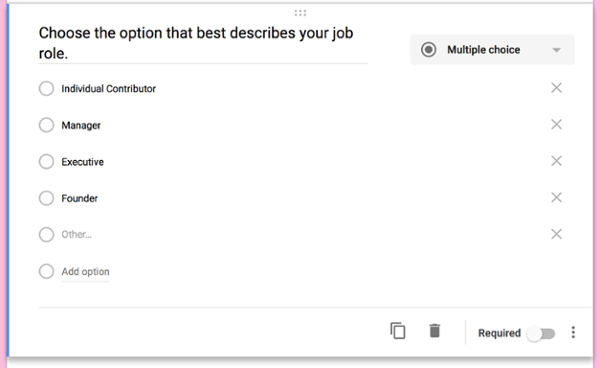When you think about product-market fit, you want to think of your product as being so perfect for your customers that they become your salespeople. You want it to be made just for them, and result in:

- Existing users recognizing your product’s value.
- Customers boasting about their great experience with the product.
- Your company replicating the excellent experience for the new users.
This is likely every business’ end goal — to provide enough value to customers that they become your advocates and help you grow your customer base.
Given this, every business should care about understanding, and achieving, product-market fit. In this post, learn what product-market fit is and understand how to measure it for your own business success.
What is product-market fit?
Product-market fit is when your product addresses and solves the needs of your buyer personas in correlating market segments and channels. Using this framework can potentially result in more business success than without proper alignment.
A simplified definition is in the name: your product fits into the market, is where it is supposed to be, and you grow your business because of it.

Why is product-market fit important?
It’s important to determine the product-market fit of your product before you launch to better position it in front of those looking for it. After all, creating a valuable business takes more effort to build than just a financial investment on a whim.
When you conduct research, it should be grounded in the needs of your target demographics, market segment, and product specs.

Free Product Go-to-Market Kit
Free templates to ensure that your whole team is aligned for your next product launch.
- Product Launch Template
- Product Roadmap Template
- Sales Plan Template
- And more!
How To Measure Product-Market Fit
The most tangible way to assess your product-market fit and understand how consumers view your products is by sending them surveys. The questions in these surveys are pointed and ask customers if they think your product is a must-have and if they would miss it if it were gone.
Product-Market Fit Questions
You can provide many qualitative questions to prospects or customers to better understand their buyer behavior and needs.
1. Multiple Choice Questions

When you design your surveys, you want to ensure that all questions can aid you in better understanding the buyer persona that looks for your business.
This can range from asking for information on their location, demographic, career aspirations, or current priorities to better envision the target market your product is going to serve.
2. Open-Ended Questions
The following questions are open-ended and can help you understand how well your product fits into the market based on your consumers' individual experiences.
- “What is the main benefit that you get from using [your product name]?”
- “What type of person would benefit most from [your product name]?”
- “How can we improve [your product name] to best meet your needs?”
- “What motivated you to use our product?”
- “Why are you using our product as opposed to other solutions?”
- “What makes our product a must-have product?”
Pro Tip: The 40% rule is a popular metric for understanding product-market fit survey results. It states that if at least 40% of customers say they would be “very disappointed” if they no longer have access to your product or service or consider it a “must-have” (wouldn’t use an alternative), you’ve created a product that fits into the market.
Product-Market Fit Goals for Startups
Many startups fail because they waste money on products that no one wants to buy. Startups should prioritize product-market fit above all other goals because those that find it will dramatically increase their odds of success.
To avoid this fate, ensure you understand the pain points your product solves, and your customers seek to solve. You can do this by focusing on six primary areas, which we’ll discuss below.
1. Determine your target customer.
Work to identify the target customer who represents the users that will most likely benefit from your product. Use market segments to define your ideal customer, and develop buyer personas for those customers, so your team will clearly understand whom it's building toward.
TechStars’ Entrepreneur in Residence Sean Higgins defines this process in four steps:
- Analyzing your product or service
- Familiarizing yourself with your competition
- Choosing segment criteria
- Performing research
The research phase is carefully crafted around defining your buyer persona, identifying which part of that persona you’ll target, conducting market research with prepared research questions, and summarizing your findings into digestible takeaways to share with your individual contributors, executives, and board.
2. Gather intelligence.
Talk to your customers to determine their pain points and how much they would consider paying for a solution to those challenges. Seek insights from your sales and marketing teams to identify recurring customer complaints.
Collect a large enough data sample to provide meaningful feedback. Consider, too, that face-to-face conversations will often generate feedback that online surveys will not.
3. Focus on a single vertical.
Startups have notoriously small budgets, which means that trying to sell your products to everyone will likely result in disaster. Begin with a narrow focus and dive deep into that industry. Establish yourself as the industry expert in a single domain to stimulate a viral spread.
For example, ChocoSol is an artisanal dark chocolate manufacturer and trader. Its founder, Michael Sacco, has worked to harvest cacao from Oaxaca, Mexico, and has extensive knowledge of what it takes to make chocolate in an ecological and dignified way.

This company demonstrates credibility or expertise in the vertical market of chocolate, whereas other businesses like candy shops or grocery stores may only be equipped with more general knowledge.
4. Specify your value proposition.
Determine which customer needs you can best address with your product or service. Figure out how you can outperform your competitors and surprise your customers. Don’t lose sight of your product roadmap when determining which challenges you’ll address; not every problem will fit into yours.
For example, Digit, a money management app, has a clear value proposition to help customers achieve financial stability and freedom, without having to think about it with the simple statement, "Stress less about your money."

5. Measure your product-market fit.
You must measure your performance to manage your success. Identify key data points that will help you track performance. Start by identifying your total addressable market (TAM), otherwise known as the total number of people who can benefit from your product/service (i.e., If everyone who could use your product/service started using it).
TAM is calculated by multiplying your average revenue per user (ARPU) by the total potential customers in the market. Once you have your TAM, determine what percentage of your TAM are current customers.

Once TAM is determined, the next part of product fit is product validation. You want to ensure that the product works and is usable and desirable to your target customer. Ask your customers if they want or need this product, send out surveys and conduct interviews, these are a part of the product validation process.

Free Product Go-to-Market Kit
Free templates to ensure that your whole team is aligned for your next product launch.
- Product Launch Template
- Product Roadmap Template
- Sales Plan Template
- And more!
6. Avoid complacency.
If you manage to achieve product-market fit, don’t assume you’ll always have it. Your customers’ needs will change over time, and you must constantly re-evaluate market conditions to continue meeting those needs.
An example of complacency can be seen in the market of online communication services is Skype. In 2020 when remote business and learning skyrocketed due to unprecedented change across the world, people were scrambling to use and share easy-to-use,
Zoom fulfilled the product-market need quickly and now, almost half of the working adult population regularly uses Zoom over Skype, Microsoft Teams, and many more services in that industry.

Product-Market Fit Examples
1. Spotify: Music for Everyone
Daniel Ek, CEO of Spotify, recognized that many of the necessary pieces for product-market fit were already in place when music-sharing platform Napster collapsed in 2001, following allegations of copyright infringement.
The content already existed, mobile devices stood poised to distribute the music, and Napster had amassed a sizable market of users. Ek believed in the possibility that this market of users would pay a small fee for a platform providing legal access to music.

With time, technology evolved and Spotify grew into using refined web content crawlers and natural language processing technology, and the popularity of Spotify grew exponentially among the market of young people. And as of 2022, Spotify has amassed 182 million paid subscribers, demonstrating the success derived from recognizing a market need and product worth investing in.
2. Uber: The Free Ride
Uber captured product-market fit by initially offering free rides between regional tech events in San Francisco. Uber’s co-founders recognized that the taxi system was prohibitively expensive and outdated, and few people used it. Once the Uber app gained steam, the company offered 50% discounts to first-time users.
Experts point to Uber’s ability to solve a problem and create a need simultaneously. Consumers weren’t demanding better taxi service, but users began to rely on the concept once a more convenient and simpler option emerged. The network effect kicked in, and users began sharing their experiences on social media, providing social proof for the startup.
To date, Uber has about 93 million riders, and the company recorded 4.98 billion rides in 2020 alone.
In most cases, product-market fit doesn’t happen on the first try. You’ll likely test and adjust your product or service several times before you find the perfect combination of value proposition, customer base, and distribution.
Continually experiment based on audience feedback, adjust your concept if your data indicates it, and be prepared to pivot if necessary.
Find the Right Fit for Your Product
When you achieve product-market fit, your job will become much easier because your customers and other interested parties will become a significant part of your marketing effort. They might even share their own stories with others so you can focus on the work of creating the same great experience for everyone who interacts with your company.
Editor's Note: This article was originally published in June 2021 and has been updated for comprehensiveness.
![→ Download Now: Free Product Marketing Kit [Free Templates]](https://no-cache.hubspot.com/cta/default/53/08b5e1f4-5d26-405b-b986-29c99bd0cb14.png)



![How to Start a Business: A Startup Guide for Entrepreneurs [Template]](https://blog.hubspot.com/hubfs/How-to-Start-a-Business-Aug-11-2023-10-39-02-4844-PM.jpg)


![How to Write a Business Proposal [Examples + Template]](https://blog.hubspot.com/hubfs/how-to-write-business-proposal%20%281%29.webp)



